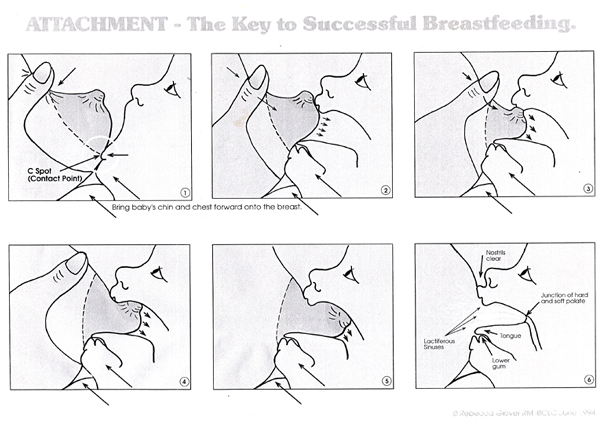One of the most important things that we can discuss in the Breastfeeding 101 series is proper latch. Your baby latching on properly is the key to the start of a successful nursing relationship. As we have discussed in previous posts, breastfeeding is a learning experience for both mother and child. In this post we’ll talk about what the proper latch looks like and how to help your baby achieve it.
When I was preparing for the birth of our first child I took at breastfeeding class, which was one of the best decisions I made. Before going into the class, I just assumed that the proper latch involved the entire nipple and areola being taken into the baby’s mouth. I soon learned that this was not necessarily so.
The proper latch will have the baby’s lower gum well below the nipple, on the areola (the dark area around the nipple). You will be able to see the areola above the baby’s upper lip. It looks a little bit like a crescent moon shape. The baby’s lips will be flared out on both top and bottom. They should not be tucked into the mouth. The photo above demonstrates this beautifully. To facilitate this:
- Get into a comfortable and supported position for breastfeeding.
- Start by lining the baby’s nose up with your nipple.
- You may need to encourage your baby to open her mouth wide by brushing her upper lip with your nipple. You want to see the baby’s mouth wide open (as if she was yawning) and the tongue covering the bottom gums (see image below). This might take a few times of encouraging the baby to open her mouth. If the tongue is not covering the bottom gums and the mouth is not wide open, it can result in the baby chomping down on your nipple. A newborn can chomp down pretty hard! Also, the baby will not be able to take the nipple in at the correct angle, which prevents let down and results in a very unhappy baby.
- Bring the baby to the breast, chin first, then nose.
Below is an excellent rendering of what the proper latch looks like from an internal view.

You’ll notice that the nipple is angled upwards and goes far back into the throat. Did you know your breast could do that??? Don’t worry, the baby will not choke. The baby nurses from the areola and the nipple. The nipple should reach all the way to the baby’s soft palette.
Touch your tongue to the roof of your mouth and you will feel the hard palette of your mouth. If you bring your baby to your breast and your nipple stops at the hard palette of baby’s mouth, when she starts to nurse it will hurt like heck! The baby will effectively be clamping the nipple between their tongue and their hard palette, which really hurts.
Now touch your tongue farther back against the roof of your mouth until you feel the soft area in the back. This is the soft palette and this is where your nipple needs to be for the baby to nurse efficiently. When baby starts to nurse, they encourage the milk ducts to let down (release the milk) by massaging the areola and stimulating the release of the milk. This cannot happen if the areola and nipple are not far enough back in the baby’s throat.
How can you tell if you have achieved proper latch?
The first 10-30 seconds of a breastfeeding session can be a little bit painful as the baby starts to massage and the milk lets down. If you feel pain beyond that first 10-30 seconds then chances are the baby is not latched on properly. Gently insert your pinky into the corner of the baby’s mouth to release the suction and remove the baby from the breast. Take a look at your nipple. You may find that it looks pinched, indicating that the nipple was being clamped between the tongue and the hard palette. Try latching again, and keep trying until baby gets a good latch. Many breastfeeding problems can be solved with paying careful attention to the latch. If you are having trouble achieving the proper latch, if breastfeeding continues to be painful for you or the baby seems frustrated and hungry all of the time, seek the help of a lactation consultant.
Tips for achieving the proper latch:
- Make sure you are in a comfortable position. Use pillow to support you.
- Wait for it. If the baby’s mouth is not wide open, with the tongue covering the bottom gums, just try again.
- Avoid using scented body lotions. They can be too much for the baby and cause the baby to refuse the breast.
- If you have large breasts, support the breast with your hand, if possible.
- Take a moment to burp the baby before nursing on each side. If the baby has any trapped gas, they will likely refuse the breast or fuss at the breast, even though they are acting as though they are hungry.
- Do not wait for the baby to cry to be fed before you feed him. A frustrated baby will have a harder time latching on correctly.